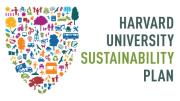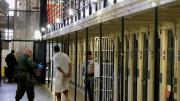The University has released an updated sustainability report, detailing its progress from fiscal year 2006 through fiscal year 2014 in five core areas—energy and emissions, campus operations, nature and ecosystems, health and well-being, and culture and learning.
Last October, Harvard unveiled an ambitious, inaugural, five-year Sustainability Plan setting priorities to build on its existing greenhouse-gas-reduction goals and detailing a strategy. (The plan, officials said, aligned Harvard’s decentralized campus around “a holistic vision,” exemplified by its colorful new emblem, and sets University-wide priorities based on innovations and solutions that have been developed within individual schools and departments.)
Overall, the online-only report details Harvard’s progress in several areas, including a 2 percent reduction in University-wide energy use—when taking growth and renovations into account—and a 17 percent reduction if excluding growth. (All energy-intensive spaces on campus have been audited, and more than 1,300 energy efficiency measures implemented.) According to the report, 98 percent of Harvard’s emissions are associated with heating and electricity use in buildings, and 60 percent of emissions reduction to date came from fuel switching at campus utility plants, as well as reductions in buildings’ energy use.(There was a slight increase in GHG emissions from 2013 through 2014 due mainly to a colder than average winter and party to new construction and renovations.)
Other highlights include the 97 LEED certified building projects that have been constructed on Harvard’s campus—the most of any higher education institution in the world, according the report. (In 2014, Harvard updated its Green Building Standards with new requirements for healthy-materials disclosure and special considerations for energy-intensive lab and IT spaces.) University-wide greenhouse-gas emissions have been reduced by 21 percent since 2006, just nine points below the 30 percent reduction goal that’s been set for 2016. Meanwhile, trash per capita has been cut 27 percent, putting Harvard more than halfway to its 2020 goal of a 50 percent reduction in this category. University-wide water use has dropped by 21 percent. As for transportation: 87 percent of Cambridge/Allston commuters, and 85 percent of Longwood commuters, use Harvard-subsidized sustainable transportation to get to work. (The number of commuters driving alone to work in Cambridge/Allston dropped from 17 percent to 13 percent, and in Longwood from 22 percent to 15 percent.) The rate of bicyclists in Longwood doubled to 11 percent.
“In aligning our public reporting with the goals and aspirations laid out in Harvard’s Sustainability Plan we hope to spark a robust conversation with our community about how we can best drive innovation and move forward for a better future,” wrote Heather Henriksen, director of the Harvard Office for Sustainability, in an e-mail to the Harvard community. “Our efforts are focused on connecting research and teaching with on-campus action to model an institutional pathway to a healthier, more sustainable future.”









